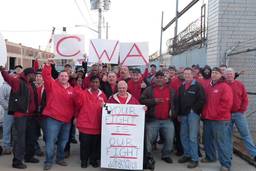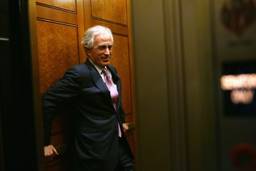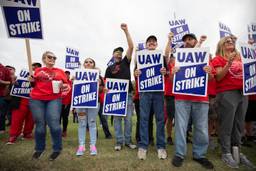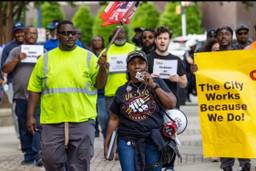
Guns not only pose a risk from the violence they inflict, but the lead content in their bullets are equally dangerous to firing range workers. From Mother Jones:
It’s all in the lead. A recent report from the National Academy of Sciences found that OSHA lead exposure standards are too lax to protect military firing range employees. Repeated exposure to the toxic metal causes a raft of health problems including brain damage, high blood pressure, and anemia.
Lead is found in bullets as well as the explosive that ignites gunpowder. When a bullet is fired, it gets so hot that that lead actually vaporizes. Firing range employees breathe in the lead fumes, as well as ingest lead dust that settles on their body and clothes. OSHA sets the permissible level of atmospheric lead at 50 micrograms/meter2, but the report found that level frequently exceeded at military firing ranges, sometimes by several orders of magnitude.
The new report also finds OSHA’s blood lead level recommendation of 40 µg/dL or lower to be too high. That limit hasn’t changed since 1978, but subsequent research has found health problems at blood lead levels as low as 5 µg/dL. Lead is so damaging because it mimics calcium, an ion with essential roles everywhere in the body from bones to nerve cells. (It’s especially dangerous for children with developing brains, which is why you hear so much about lead paint.) The report devotes more than 70 pages to detailing lead’s many toxic effects in nearly every organ in the body, including the brain, blood, kidneys, heart, and reproductive organs.
In other news, early signs of Post Traumatic Stress Disorder are starting to appear in the civil servants of Newtown, Conn., who were first upon the scene following last month’s mass-shooting at Sandy Hook Elementary. From The Washington Post:
“I think there’s a general concern about law enforcement officers, EMS, firefighters,” Kehoe said. “We all see horrific things in our daily jobs. . . . Certainly, at all times we are really concerned about first responders who saw unimaginable things that day. . . . We tell officers, ‘Feel free to see the clinician of your choice and get the help you need for you and your families.’”
The town’s gratitude is visible. Outside the station, a big sign fixed to a tree on a neighboring property says, “THANK YOU FIRST RESPONDERS.” Less than a mile up Main Street, entire walls of the Newtown Volunteer Ambulance Corps’ station are papered with thank-you cards and e-mail printouts from far-flung people expressing their awe, thanks and best wishes (“I would like to wish you a safe journey”). From this station, 70 unpaid EMTs take turns serving 60 square miles and responding to 150 to 200 calls a month.
On Thursday afternoon at 3:30, EMT Mike Collins returned to the steepled station, located on a former gas-station plot, after attending a single-vehicle accident on the highway (driver dozed off, injuries were minor). With 2 1/2 hours left in his 12-hour shift, Collins considered the conundrum of arriving at a scene that can’t be triaged. On Dec. 14, the ambulance corps was adrenalized and ready to serve. Collins was halfway to Sandy Hook in his own vehicle when word came over the radio that the ambulances were being sent back to the station.
He sat in the station for the next 10 hours as his fellow EMTs returned, visibly shaken from responding to a tragedy of such magnitude and irreversibility.
Last year, In These Times reported that the National Labor Relations Board had ordered Castlewood Country Club to pay workers $1.8 million in back wages for an illegal lockout. Now the country club is refusing to pay up. From The East Bay Express:
Picketing near the frosty front nine of the Castlewood Country Club in Pleasanton, workers who were locked out for more than 900 days are demanding management pay them $1.8 million in back pay and benefits following a judge’s order ending the lockout earlier this year. The National Labor Relations Board in August declared Castlewood’s lockout of workers, which began August 10, 2010, was illegal and found the country club had engaged in unfair bargaining practices. The judge also ordered Castlewood to reimburse the 61 locked out service and hospitality workers — 45 of who returned to work October 16. The club, however, had failed to reimburse the workers and the workers are still seeking a new contract.
Earlier this year, the Express detailed allegations against Castlewood’s attorney for attempting to alter notes taken during a bargaining session with representatives of the UNITE HERE Local 2850, who represent the employees. The allegation was also cited in the harshly worded judgment in August against the country club, which has until tomorrow at 5 p.m. to decide whether to appeal the orders.
Castlewood officials declined to comment Thursday on whether they would appeal. However, union officials say management have indicated to them they will do so.
The NLRB says that the United Auto Workers and Ford engaged in illegal collusion to deny jobs to Teamsters, who were less willing to accept concessions than the UAW members. From Labor Notes:
Collusion between the United Auto Workers and a Ford contractor to cut wages and oust Teamsters members was flagrant, says the NLRB — so flagrant that the board is seeking an injunction to get displaced Teamsters their jobs back more quickly.
The December 21 decision by a National Labor Relations Board administrative law judge details how Voith Industrial Services, with Ford Motor Co. pulling the strings, underbid a carhaul company that had moved new cars out of Ford’s Louisville, Kentucky, assembly plant since 1952. To make the low bid, Voith prearranged a substandard contract with UAW Local 862, which represents the workers who build Ford Escapes at the plant.
The judge ordered Voith to put 85 named Teamsters to work, pay them nearly a year’s back-pay, reinstate the superior terms of the Teamster contract, and void the deal the company signed with the UAW. The judge also ordered that the decision be read aloud at meetings of all Voith workers.
Under the terms of the Voith-Ford-UAW arrangement, in early 2012 Teamsters who made $20 per hour, with a union pension, were replaced by newly hired workers making $11-14 per hour.
The NLRB has ruled that employers can no longer use anonymous witness statements in the early stages of bringing discipline against union members. From JDSupra Law News:
The Board concluded that the general rule of law concerning an assertion that relevant information is confidential is the appropriate analysis. The general principles regarding that test are:
- If a party asserts that requested information is confidential, the Board balances the union’s need for the relevant information against any legitimate and substantial confidentiality interests established by the employer. Merely asserting confidentiality (or apparently that the witness gave the statement pursuant to a claim that it would remain confidential) is not enough, there must be some other articulable reason;
- The party asserting the confidentiality interest bears the burden of establishing that interest; and
- A party refusing to supply information on confidentiality grounds has a duty to seek an accommodation.
In sum, the clear cut, bright line exemption that witness statements are not discoverable in pre-arbitration information requests is now a thing of the past. Now, the rule is that witness statements, if requested, must be disclosed. If an employer wishes to assert that a witness statement is confidential, it bears the burden of establishing a real confidentiality interest but it must always bargain with the union over whether there is a way to accommodate the request. An example of at least one type witness related issue that has been deemed confidential in the past includes the names of informants to drug use or theft.
As with other recent decisions where the NLRB changed existing law, the agency held that the new rule will apply only prospectively.

I hope you found this article important. Before you leave, I want to ask you to consider supporting our work with a donation. In These Times needs readers like you to help sustain our mission. We don’t depend on—or want—corporate advertising or deep-pocketed billionaires to fund our journalism. We’re supported by you, the reader, so we can focus on covering the issues that matter most to the progressive movement without fear or compromise.
Our work isn’t hidden behind a paywall because of people like you who support our journalism. We want to keep it that way. If you value the work we do and the movements we cover, please consider donating to In These Times.







